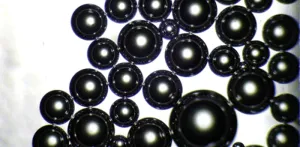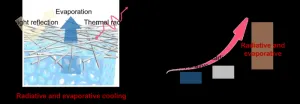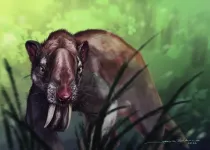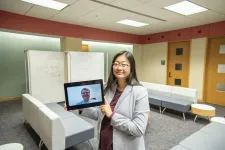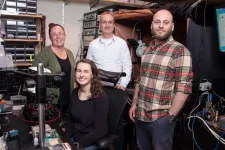(Press-News.org) Microplastics are tiny plastic particles less than 5 mm in diameter that have emerged as a novel marine environment pollutant. Microplastics usually result from a breakdown of larger plastic debris but can also be generated from plastic microbeads used in personal care products. Over the years, there has been a significant buildup of microplastic pollutants in our oceans, with a recent estimate that the world’s oceans contain over 24.4 trillion pieces of microplastics weighing between 82,000 and 578,000 tons. It is highly likely that microplastics are being consumed by marine organisms and have pervaded the aquatic food chain.
Additionally, microplastics have negatively affected the marine ecosystem by hindering light transmission through the ocean waters. This has disrupted the functioning of photosynthetic organisms, such as phytoplankton and algae, which can lead to a cascading effect on the entire food chain. It is, therefore, imperative to assess the radiative properties (absorption and scattering) of microplastics to determine the extent of disruption they cause to light propagation.
Fortunately, in a new study published in Optical Engineering, researchers from China and Singapore rose to the occasion. In their study, they determined the absorption coefficient and reflectivity of polyamide-12 (PA12), a common marine microplastic pollutant that is generated in the clothing, cosmetic, and packing industries. The researchers specifically focused on measuring two important parameters: the absorption coefficient, which indicates the amount of light absorbed, and the extinction coefficient, which accounts for the light attenuated (absorbed and scattered) by the particles.
Accordingly, they constructed an optical experimental setup containing a light source, optical fibers, an adjustable cuvette holder to hold the microplastic solution being inspected, and a spectrometer to assess the amount of light transmitted through the sample. For the microplastic solution, they prepared a suspension containing PA12 particles with a mean diameter of about 97.8 µm. To assess the degree of light scattering, they measured the amount of light transmitted through a glass cuvette containing deionized water without any contaminant to set a benchmark. They then repeated the experiment with microplastic powder suspension in a quartz glass cuvette. From these measurements, they estimated the extinction coefficient of PA12.
The absorption parameters were measured similarly. The researchers used an integrating sphere to collect the light scattered by the microplastic suspension in different directions and directed it toward a spectrometer for analysis.
The analysis revealed a scattering albedo (ratio of scattering efficiency to total extinction efficiency) of 0.7 for the PA12 suspension, implying that most of the light passing through it was scattered. “The scattering-dominated characteristic of PA12 changes the distribution of light in seawater, which, in turn, affects the marine ecology,” said Dr. Chunyang Ma, the corresponding author of the study.
Additionally, the PA12 particles were found to absorb the incident radiation at certain specific wavelengths. “Absorption peaks of PA12 were observed at wavelengths of 692, 728, 764, 800, 835, and 940 nm. These correspond to the vibrational absorption of methylene and amide groups,” Ma said.
With these insights, the researchers suggest that the radiative properties of PA12 can be used to optically monitor the flow of microplastics into oceans. This, in turn, could help us prevent their entry into the aquatic as well as terrestrial food chain, mitigating its threat to all forms of life, including humans.
Read the paper by Wen et al., “Thermal radiative properties of polyamide-12 from 0.2 to 1.1 μm” Opt. Eng. 62(3) 034102 (2023). doi: 10.1117/1.OE.62.3.034102.
END
Using optics to trace the flow of microplastics in oceans
Researchers examine how microplastic pollutants affect ocean light transmission as a way to track their flow into the marine ecosystem
2023-03-21
ELSE PRESS RELEASES FROM THIS DATE:
First results from ESO telescopes on the aftermath of DART’s asteroid impact
2023-03-21
Using ESO’s Very Large Telescope (VLT), two teams of astronomers have observed the aftermath of the collision between NASA’s Double Asteroid Redirection Test (DART) spacecraft and the asteroid Dimorphos. The controlled impact was a test of planetary defence, but also gave astronomers a unique opportunity to learn more about the asteroid’s composition from the expelled material.
On 26 September 2022 the DART spacecraft collided with the asteroid Dimorphos in a controlled test of our asteroid deflection capabilities. The impact took place 11 million kilometres away ...
Obesity risk may pass from mothers to daughters
2023-03-21
WASHINGTON—Women with obesity may share risk for the disease with their daughters, but not their sons, according to a new study published in the Endocrine Society’s Journal of Clinical Endocrinology & Metabolism.
Obesity is a common, serious and costly disease affecting nearly half of the adults and 20 percent of children in the United States. It costs an estimated $173 billion in medical care costs. People with obesity are at higher risk of developing diabetes, high blood pressure, heart ...
New program for veterans with high cholesterol, associated cardiovascular disease
2023-03-21
DALLAS, March 21, 2023 — More than 2 million veterans are living with atherosclerotic cardiovascular disease (ASCVD) and require management of their high cholesterol, according to the Department of Veterans Affairs (VA). Left unaddressed, high cholesterol increases the chance of experiencing heart attack and stroke. To control high cholesterol among veterans, the American Heart Association, the world’s leading nonprofit organization focused on heart and brain health for all, in collaboration with the VA, ...
An integrated approach to cool: how evaporation and radiation can cool the world
2023-03-21
Large-scale, effective, and passive: these descriptions are aptly given to the integrated radiative and evaporative chiller (IREC), designed and tested by researchers at Tsinghua University in Beijing, China. The goal of this technology is to come up with an energetically affordable method of cooling to aid in the rising consumption of energy while still minimizing carbon emissions through the process.
“Energy scarcity is a universal challenge to global development. The demand for ...
TAMEST names MD Anderson’s Dr. Florencia McAllister recipient of the 2023 Mary Beth Maddox Award & Lectureship
2023-03-21
TAMEST (The Texas Academy of Medicine, Engineering, Science and Technology) has announced Florencia McAllister, M.D., The University of Texas MD Anderson Cancer Center, as the recipient of the 2023 Mary Beth Maddox Award and Lectureship in cancer research. She was chosen for her seminal discoveries at the intersection of microbes, the immune system and pancreatic cancer, leading to insights into early detection, prevention and therapeutic strategies to fight the disease.
The Mary Beth Maddox Award and Lectureship ...
Family Heart Foundation research finds high-risk Americans who do not maintain guideline recommend LDL-C targets have 44% higher rate of cardiovascular events
2023-03-21
SAN ANTONIO, March 21, 2023 – A real-world, retrospective analysis by the Family Heart Foundation, a leading non-profit research and advocacy organization, found that high-risk Americans who do not maintain levels of LDL-cholesterol (LDL-C) recommended in the 2018 American College of Cardiology/American Heart Association cholesterol treatment guidelines, had a 44% higher rate of cardiovascular events compared to those who did achieve and maintained recommended LDL-C levels. The study findings, which were based on data from the Family Heart DatabaseTM of more than 300 million Americans, will be ...
Forest growing season in eastern U.S. has increased by a month
2023-03-21
COLUMBUS, Ohio – The growing period of hardwood forests in eastern North America has increased by an average of one month over the past century as temperatures have steadily risen, a new study has found.
The study compared present-day observations of the time span from budburst to peak leaf coloration in seven tree species to similar documentation that was collected by an Ohio farmer at the turn of the 20th century.
An analysis of changes in those leaf patterns along with decades of temperature data for northwest Ohio showed a clear connection between increased warming during winter and spring and an extended period of tree growth.
The implications of the longer growing period – ...
How the "marsupial sabertooth" thylacosmilus saw its world
2023-03-21
A new study investigates how an extinct, carnivorous marsupial relative with canines so large they extended across the top of its skull could hunt effectively despite having wide-set eyes, like a cow or a horse. The skulls of carnivores typically have forward-facing eye sockets, or orbits, which helps enable stereoscopic (3D) vision, a useful adaptation for judging the position of prey before pouncing. Scientists from the American Museum of Natural History and the Instituto Argentino de Nivología, ...
Molecular teamwork makes the organic dream work
2023-03-21
The virus responsible for E. coli infection has a secret weapon: teamwork.
Always scrappy in its bid for survival, the virus alights on an unassuming host cell and grips the surface with the business end of its tubular tail. Then, the proteins in the tail contract in unison, flattening its structure like a stepped-on spring and reeling the virus's body in for the critical strike.
Thanks to the proteins' teamwork, the tail can flex and flatten with ease. This process, called molecular cooperativity, is often observed in nature but rarely ...
Wearable microscopes advance spinal cord imaging in mice
2023-03-21
LA JOLLA—(March 21, 2023) The spinal cord acts as a messenger, carrying signals between the brain and body to regulate everything from breathing to movement. While the spinal cord is known to play an essential role in relaying pain signals, technology has limited scientists’ understanding of how this process occurs on a cellular level. Now, Salk scientists have created wearable microscopes to enable unprecedented insight into the signaling patterns that occur within the spinal cords of mice.
This technological advancement, detailed in two papers published in Nature Communications ...
LAST 30 PRESS RELEASES:
Injectable breast ‘implant’ offers alternative to traditional surgeries
Neuroscientists devise formulas to measure multilingualism
New prostate cancer trial seeks to reduce toxicity without sacrificing efficacy
Geometry shapes life
A CRISPR screen reveals many previously unrecognized genes required for brain development and a new neurodevelopmental disorder
Hot flush treatment has anti-breast cancer activity, study finds
Securing AI systems against growing cybersecurity threats
Longest observation of an active solar region
Why nail-biting, procrastination and other self-sabotaging behaviors are rooted in survival instincts
Regional variations in mechanical properties of porcine leptomeninges
Artificial empathy in therapy and healthcare: advancements in interpersonal interaction technologies
Why some brains switch gears more efficiently than others
UVA’s Jundong Li wins ICDM’S 2025 Tao Li Award for data mining, machine learning
UVA’s low-power, high-performance computer power player Mircea Stan earns National Academy of Inventors fellowship
Not playing by the rules: USU researcher explores filamentous algae dynamics in rivers
Do our body clocks influence our risk of dementia?
Anthropologists offer new evidence of bipedalism in long-debated fossil discovery
Safer receipt paper from wood
Dosage-sensitive genes suggest no whole-genome duplications in ancestral angiosperm
First ancient human herpesvirus genomes document their deep history with humans
Why Some Bacteria Survive Antibiotics and How to Stop Them - New study reveals that bacteria can survive antibiotic treatment through two fundamentally different “shutdown modes”
UCLA study links scar healing to dangerous placenta condition
CHANGE-seq-BE finds off-target changes in the genome from base editors
The Journal of Nuclear Medicine Ahead-of-Print Tip Sheet: January 2, 2026
Delayed or absent first dose of measles, mumps, and rubella vaccination
Trends in US preterm birth rates by household income and race and ethnicity
Study identifies potential biomarker linked to progression and brain inflammation in multiple sclerosis
Many mothers in Norway do not show up for postnatal check-ups
Researchers want to find out why quick clay is so unstable
Superradiant spins show teamwork at the quantum scale
[Press-News.org] Using optics to trace the flow of microplastics in oceansResearchers examine how microplastic pollutants affect ocean light transmission as a way to track their flow into the marine ecosystem
